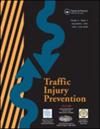Managing the road safety risks of last mile deliveries: Do telematics have a role to play?
IF 1.6
3区 工程技术
Q3 PUBLIC, ENVIRONMENTAL & OCCUPATIONAL HEALTH
引用次数: 0
Abstract
Objective
The research aimed to understand the impact of telematics in reducing traffic violations and crashes among drivers working in parcel delivery and the perceived utility, effectiveness, and acceptability of telematics among drivers using them. The objective was to carry out an online survey among drivers who have telematics versus drivers who do not and compare their behaviors in terms of risks and violations controlling for key demographics an exposure.
Methods
An online anonymous survey was conducted of 780 home delivery drivers of which 430 used telematics in 2022. The survey was conducted by a fieldwork company and participants were compensated for their time. Univariate and multivariate analysis was conducted on the data.
Results
Telematics users did not report less crashes than drivers who did not use telematics. Most drivers, irrespective of telematics use agreed that the time pressure of delivery work increased speed limit violations and unsafe or hazardous parking. Multivariate analysis indicated that damage collisions for all drivers were associated with factors such as, driving medium to large vans, hazardous behavior related to parking, and having penalties for violations, especially related to speed. Delivery drivers, while generally facing pressure to speed and take risks to meet delivery schedules, did perceive telematics as a tool for safety enhancement and information dissemination, as well as for the management of performance. Non-telematics users viewed it with skepticism.
Conclusions
Telematics alone may not ensure the safety of last-mile deliveries and could potentially increase the pressure of deliveries. This research underscores the need for a holistic approach to road safety in the home delivery sector, combining telematics technology with a proactive safety culture.
管理最后一英里送货的道路安全风险:远程信息处理系统能发挥作用吗?
研究目的研究旨在了解远程信息处理系统在减少从事包裹递送工作的司机的交通违章和交通事故方面的影响,以及使用远程信息处理系统的司机对其实用性、有效性和可接受性的看法。我们的目标是对使用远程信息处理系统的司机和未使用的司机进行在线调查,并比较他们在风险和违规方面的行为,同时控制主要的人口统计数据和接触情况:对 780 名宅配司机进行了在线匿名调查,其中 430 人在 2022 年使用了远程信息处理系统。调查由一家实地调查公司进行,参与者获得了时间补偿。对数据进行了单变量和多变量分析:结果:与未使用远程信息处理系统的驾驶员相比,远程信息处理系统用户报告的碰撞事故并没有减少。无论是否使用远程信息处理系统,大多数驾驶员都认为,送货工作的时间压力增加了违反限速规定和不安全或危险停车的情况。多变量分析表明,所有驾驶员的损坏碰撞事故都与以下因素有关,如驾驶中型到大型货车、与停车有关的危险行为、违章处罚,尤其是与车速有关的违章处罚。虽然送货司机普遍面临着超速和冒险以满足送货计划的压力,但他们确实认为远程信息处理系统是加强安全、传播信息和管理绩效的工具。非远程信息处理系统用户则对其持怀疑态度:结论:仅靠远程信息处理系统可能无法确保最后一英里送货的安全,还有可能增加送货的压力。这项研究强调,在送货上门行业中,需要采取综合的道路安全方法,将远程信息处理技术与积极主动的安全文化相结合。
本文章由计算机程序翻译,如有差异,请以英文原文为准。
求助全文
约1分钟内获得全文
求助全文
来源期刊

Traffic Injury Prevention
PUBLIC, ENVIRONMENTAL & OCCUPATIONAL HEALTH-
CiteScore
3.60
自引率
10.00%
发文量
137
审稿时长
3 months
期刊介绍:
The purpose of Traffic Injury Prevention is to bridge the disciplines of medicine, engineering, public health and traffic safety in order to foster the science of traffic injury prevention. The archival journal focuses on research, interventions and evaluations within the areas of traffic safety, crash causation, injury prevention and treatment.
General topics within the journal''s scope are driver behavior, road infrastructure, emerging crash avoidance technologies, crash and injury epidemiology, alcohol and drugs, impact injury biomechanics, vehicle crashworthiness, occupant restraints, pedestrian safety, evaluation of interventions, economic consequences and emergency and clinical care with specific application to traffic injury prevention. The journal includes full length papers, review articles, case studies, brief technical notes and commentaries.
 求助内容:
求助内容: 应助结果提醒方式:
应助结果提醒方式:


